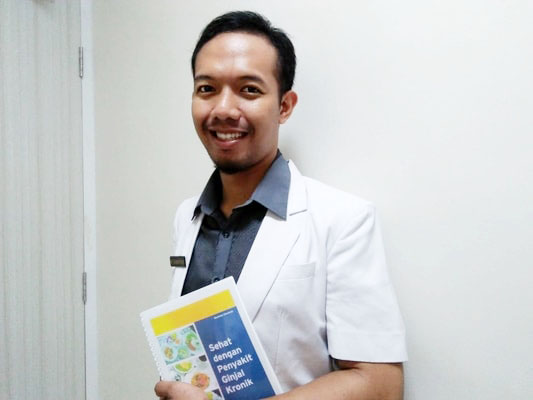Hemodialysis Service for Tuberculosis Patients
- Published: March 5, 2020
 Risk of Tuberculosis Infection
Risk of Tuberculosis Infection
After cardiovascular disease, the second cause of mortality for hemodialysis patients is getting infected. Hemodialysis patients get easily infected to various types of infections including Bloodborne infection (HBV, HCV HIV), and airborne infection (tuberculosis)
Tuberculosis (TB) itself is an infectious disease widely encountered in Indonesia. Based on the tuberculosis prevalence survey in 2013-2014, it was confirmed that the prevalence of bacteriological TUBERCULOSIS in Indonesia was 759 per 100,000 people aged above 15.
Patients with chronic renal failure undergoing hemodialysis have a risk of being infected by 10-25 times higher than those of the other patients. Those risks could be due to:
-
The immunocompromised status of the patient.
-
The blood stream during HD treatment which is exposed through the vascular access and extra corporeal circuits.
-
The insufficient space among patients in Hemodialysis room.
-
The Interaction with a health staff who frequently switches between the patient and the machine.
-
The high frequency of being hospitalized and taking surgery
-
The very little awareness of taking serious action to prevent the infection.
Problems of applying the standard of preventing the infection could be because of:
-
The bad ratio of nurses and patients.
-
The insufficient competency of Hemodialysis staff
-
The inadequate education of knowledge for patients and their family.
-
The limited number of equipment to prevent the infection.
-
The small space of Hemodialysis room and the absence of the isolation system needed.
-
The less proper precautions standard in the case of dialysis complications, like life-threatening
POLICY OF ISOLATION FOR HEMODIALYSIS SERVICE
Based on the CDC, the isolation room is only used for patients with positive HBsAg. Hepatitis B Virus can survive on the objects surface for about 7 days and infection could happen through direct or indirect contact. The surface of the object can be seriously contaminated with hepatitis B virus, although there is no evidence of liquid, blood or others. Therefore, it is compulsory to do disinfection and isolation to avoid contamination. [6] [7]
Although CDC and K-DIGO do not recommend exclusive use of the machine, patient isolation and reuse policy for Hemodialysis patients with hepatitis C, but patients should be fully aware of the universal precautions and the sterilized dialysis equipment. For HIV patients, HIV transmission rarely occurs at the dialysis service and this could be prevented by taking the standard infection prevention procedures. CDC advices that patients do not reuse the dialyzer of HIV patients, but machine and patient isolation is not necessary. [6] [7]
Policy on patients with airborne disease is not much discussed in K-DIGO. CDC states that Lung Tuberculosis is highly infectious and can be spread through the air. Precautions of airborne disease should also be taken for lung Tuberculosis patients in the dialysis unit. Patient is treated in the of Airborne Infection Isolation Room (AIIR). Air from the isolation room is not circulated again, or if air recirculation is necessary, it should be done through High Efficiency Particulate Air (HEPA) filter. 4
The minimum isolation period for pulmonary tuberculosis patients (incl. mediastinum, laryngeal, pleural and Miler) is until there is evidence of negative bacteriology at 3 different times of sputum, or 14 days after the initiation of effective treatment, and followed by the progress of their Clinical conditions (less cough, less fever, less lung infiltrates, and less amount of acid-resistant bacteria in sputum. [4] Isolation with special ventilation for Tuberculosis patients is not required if patients meet the following criteria [5]
-
Active Tuberculosis patients who already get the anti-tuberculosis treatment at least 14 days effectively, with good clinical condition and or
-
Negative result of bacterial sputum SPS or
-
For patients indicated with MDR-Tuberculosis, negative result of bacterial sputum taken in three consecutive weeks.
Dialysis Service staff should use the universal precaution (masks and gloves). Patients should also wear masks especially those suffering from serious cough. Health staff should give personal hygiene education to patients and their families. [5]
TUBERCULOSIS SCREENING
Screening for Hemodialysis patients is highly recommended by APIC, CDC, KDOQI and ERBP. The screening test is compulsory for patients with the following risk factors [7]:
-
Live in an endemic area of Tuberculosis
-
Exposed to some Social and environmental risk factors such as social workers for healthcare, detention, homeless, alcohol and drug abuse.
Tests for Tuberculosis Diagnose are [7]:
-
Thoracic photos
-
Tuberculin Skin Test (TST)
-
Interferon Gamma Release Assay (IGRA)
-
Acid Fast Bacilli Staining Test on sputum
-
Sputum Liquid Test
-
NAT test
SUMMARY
-
In dialysis, Isolation should be given to patients with positive HBsAg
-
Hemodialysis treatment for Active Tuberculosis patients should be separately done. The special treatment should be done in the Airborne Infection Isolation Room.
-
Hemodialysis treatment for non-active tuberculosis could be done together with the other patients but universal precaution like wearing masks and personal hygiene should definitely be carried out.
-
Patients with tuberculosis risk factor should take Thoracic photos screening and Tuberculin Skin Test (TST)
BIBLIOGRAPHY
-
2003. Tuberculosis Transmission in a Renal Dialysis Center https://www.cdc.gov/mmwr/preview/mmwrhtml/mm5337a4.htm
-
Information Resources of Kemenkes RI. 2018. Infodatin Tuberkulosis 2018. https://pusdatin.kemkes.go.id/article/view/18101500001/infodatin-tuberkulosis-2018.html
-
Cohn D.L., O’Brien R.J., Geiter L.J., Gordin F.M., Hershfield E., Horsburgh C.R., Jereb J.A., Jordan T.J., Kaplan J.E., Nolan C.M., Starke J.R., Taylor Z., Villarino M.E., 2000. Targeted Tuberculin Testing and Treatment of Latent Tuberculosis Infection. American Journal of Respiratory and Critical Care Medicine 2000;161:S221--S247.
-
2012. Menu of Suggested Provisions For State Tuberculosis Prevention and Control Laws. https://www.cdc.gov/tb/programs/laws/menu/isolation.htm
-
Wong T. Y., Chen H., Philip L.I., Mak S.K., Fung S., Yung R., Tong K.L., Tsang D., Lai R., Leung Y.H., Lee S., Law M.C., Tang S., Kwan T.H., Yuen M.F., Lam E., Ng A., Tsang C. 2018. Infection Control Guidelines on Nephrology Services in Hong Kong. 2018. Infection Control Branch, Centre for Health Protection, Department of Health, Hong Kong.
-
Fenves A.Z., Medical Management of the Dialysis Patient: Infectious Complications. https://www.renalandurologynews.com/home/decision-support-in-medicine/nephrology-hypertension/medical-management-of-the-dialysis-patient-infectious-complications/
-
Center for Medicaid and State Operations Survey and Certification Group. 2009. ESRD Conditions for Coverage Frequently Asked Questions. https://www.cms.gov/Medicare/Provider-Enrollment-and-Certification/SurveyCertificationGenInfo/downloads/SCLetter09_56.pdf
Articles by dr. Rhama Patria Bharata ( Medical Team of PT. Masa Cipta Husada )
Latest Info and Education
Latest News and Events
Patient's Testimony
"Although I have to do the hemodialysis therapy twice a week, I am still able to do my daily activities . Thanks to the medical team of PT Masa Cipta Husada for their support and care."





